The spinal canal protects the spinal cord and nerve roots.
Messages from the brain must first pass through the bones of the neck where the first and second cervical vertebrae are located. This is the first part of the spinal column that is closest to the brain and is subject to pressure from subluxation, and it is the part of the spinal column that needs to be carefully considered to determine the best and most natural way to heal. So that, if a subluxation occurs in this area, the supply of nerve energy from the brain is interfered with, and the body’s functions are reduced. Therefore, an upper cervical chiropractor can check for the presence of subluxations through examination and adjust them (most cases C1 major) if you wish.
After the adjustment are made, the treatment of your body will be left to your natural healing power (innate intelligence).
How to know the subluxation of the upper cervical spine?
(*In the U.S., X-rays are taken to know the condition of the spine. In Japan, chiropractic is not legalized and therefore x-rays cannot be taken by chiropractors.)
If you have X-Ray films that have been taken in the past for chiropractic analysis, please bring them with you. They will help us to learn more about your situation.
If you would like to take an X-Ray or CT scan of your cervical spine in Japan, please let your chiropractor know it. If this is possible, it can be done at a designated medical facility.
Upper Cervical Chiropractic uses several tests to analyze your unique patterns and determine if you have subluxations or not.
Five main tests
(These are the testing methods used by JSCA members that do not rely on X-Ray.)
- Skin temperature measurement on both sides of the spine
- Posture analysis
- Short legs and short hands(arms) analysis
- Palpation (static and dynamic)
- Center of gravity measurement
1.Analysis of Skin Temperature Measurement
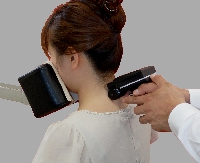 The vasomotor activity of the whole body is regulated by the medulla oblongata located at the level of the first and second cervical vertebrae. Therefore, when subluxation occurs in this area, we can see the temperature difference in this area.
The vasomotor activity of the whole body is regulated by the medulla oblongata located at the level of the first and second cervical vertebrae. Therefore, when subluxation occurs in this area, we can see the temperature difference in this area.
Also, subluxation caused by misalignment of the upper cervical vertebrae will affect the lower cervical vertebrae.
The head movement caused by the misalignment of the upper cervical vertebrae creates secondary distortions in the vertebrae, especially above and below C5, as a compensation, resulting in degenerative degeneration of the vertebrae and intervertebral discs.
Depending on the degree of deterioration, there may be a temperature goes down on both sides or one side of this area due to nerve transmission interference.
For men, the measurement is done with the naked from the waist up as the entire spinal column is measured. For women, only the cervical area is measured as shown in the picture, but in some offices, the neck and lower back area is measured.
And for women who wish to have their entire spine measured like men, they will be asked to change into a measurement gown. The graphs shown here are all measurements of the entire spine.
Temperature is not only altered by subluxations in the upper cervical spine, but also by mental stress, medications, lack of sleep, alcohol, tobacco, and overwork. So when determining the presence of subluxation, it is comprehensively determined by other complementary tests such as short legs and hands(arms), muscle palpation, vertebral mobility, and shifting of the center of gravity.
* Hot and humid summer season in Japan, your sweat may cause the entire measurement temperature or part of it to be displayed lower, but this is neither a measurement error nor an abnormality. This is a transient phenomenon that occurs as the body surface is cooled by sweat. Dr. will tell you about it when it actually happen.
Fig. A below shows the temperature during subluxation and after adjustment of it. When the subluxation is adjusted, the temperature difference between the left and right, top and bottom will be reduced and the whole body will be aligned. See Fig. A 2003/10/25 Post.(after adjustment)

The waveforms in the graphs of 2003/09/10 and 10/25 Pre. are very similar. In the case of this patient, this waveform (pattern) appears when subluxation is present.
You have your own specific subluxation pattern, and not everyone is the same.
The process of determining the specific temperature pattern on the graph is called “Pattern Analysis”.
After the upper cervical adjustment (10/25 Post.), you can see that the graph is closer to straight line and the temperature difference has disappeared.
Analyzing the pattern of the graph by measuring the temperature is important to determine if there is subluxation.
Fig. B (Instrumentation By Tytron C-3000) below shows the surface temperature measured from the neck to the waist.
There are many different models of measuring instruments. With the advancement of science and technology, the accuracy of measuring instruments has been improving year by year.
This is one of the measuring instruments installed in the office of our members, and it is displayed using computer graphics.
The data from this instrument consists of not only the graphs described in the above figure, but also a color distribution of the graphs and a blue bar display (Fig. C), which can be converted and presented in three different formats for easy understanding by patients.
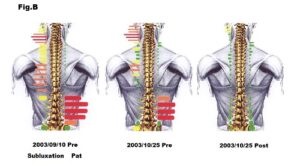
Look at the color distribution for 2003/09/10 Pre. and 2003/10/25 Pre.
This shows the temperature difference between the graphs shown in Fig. A with color bars.
Post. 2003/10/25 is the condition after the adjustment of the first cervical vertebra.
You can see that the temperature difference between the left and right side has disappeared.
The larger the temperature difference, the darker the color will be displayed (green →yellow → orange→ red). The smaller the temperature difference (green), the more ideal. Ideally, the color green should be almost uniform from the neck to the waist, as shown in this graph 2003/10/25 Post.

This blue bar shows the waveform graph in Fig. A and the color bar distribution in Fig. B, with the blue bar indicating the same temperature.
The blue bar shows the actual temperature distribution, so it is easy to see where the temperature is high and where it is low.
The longer bars (width) on the left and right side indicate areas of high temperature, and the shorter bars indicate areas of low temperature.
The lower temperatures indicate areas where nerve transmission is disturbed and blood flow is reduced.
2003/09/10 Pre. and 2003/10/25 Pre. show the same pattern.
10/25 Post. is the state after the adjustment. As the nerve transmission from the brain improves, the autonomic nervous system functions normally and the temperature difference between the left and right sides improves.
This is the proof that chiropractic diagnosis and treatment is based on the Innate (inherent) Intelligence and power of the body.
The nerve impulses from the brain transmit not only information about the body’s normal functioning, but also the power (natural healing power) to restore it to its original state, allowing the body to return to its natural state on its own.
This is why in upper cervical chiropractic, the treatment is left to nature and the chiropractor only makes adjustments of the subluxation.
These extreme color distributions and extremely short blue bar widths are where the spine is distored as a compensatory effect on the displacement of the upper cervical .
This is explained in “2. Posture Analysis”, and it suggests that nerve transmission is secondarily disturbed.
From a chiropractic point of view, the case of this patient (Pre.) is characterized by a temperature drop over the right side of the lower cervical spine when subluxation occurs in the upper cervical spine, and a temperature drop in the lumbar vertebrae 2-4, especially on the left side.
However, these are only compensations for the displacement of the upper cervical spine.
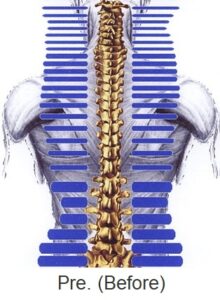 Therefore, when the displacement of the upper cervical vertebrae is removed (Post./After adjustment), not only does the temperature in the lower part of the spine change, but also the nerve transmission from the central nervous system to the muscles supporting the spine in the medulla oblongata improves, and the function of the muscles supporting the spine (anti-gravity muscles) returns to normal.
Therefore, when the displacement of the upper cervical vertebrae is removed (Post./After adjustment), not only does the temperature in the lower part of the spine change, but also the nerve transmission from the central nervous system to the muscles supporting the spine in the medulla oblongata improves, and the function of the muscles supporting the spine (anti-gravity muscles) returns to normal.
 The increase in temperature (improvement in blood flow) is a natural phenomenon that occurs removing nerve impediments in parallel as the brain restores the distortion of the spine to its original position.
The increase in temperature (improvement in blood flow) is a natural phenomenon that occurs removing nerve impediments in parallel as the brain restores the distortion of the spine to its original position.
Chiropractors do not heal.
The temperature changes in these data prove that the “cause of spine distortion” and “cause of interference with natural healing” is due to subluxation of the upper cervical spine.
2. Posture Analysis
 The head is supported by the first cervical vertebra, called the atlas.
The head is supported by the first cervical vertebra, called the atlas.
The head rotates to the right and to the left around the odentoid process (Dens) of the second cervical vertebra.
When the first cervical vertebra is misaligned, it means that the head moves with the first cervical vertebra from the center of the body.
When the head moves away from the center of the body, it puts the head in an unstable state.
At this time, the biological brain uses the muscles to compensate by creating compensatory distortions in the lower spinal column including the pelvis as a secondary distortion in order to keep the head in the center of the body as much as possible.
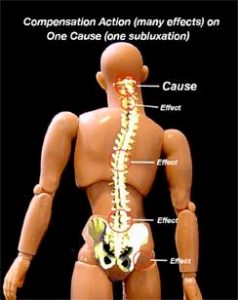 In upper cervical chiropractic, this is called “compensation” or “corrective action”. This is a unique concept of upper cervical chiropractic and is not found in medicine or general chiropractic. For this reason, upper cervical chiropractic is not concerned with distortions in the lower spine below the upper cervical area.
In upper cervical chiropractic, this is called “compensation” or “corrective action”. This is a unique concept of upper cervical chiropractic and is not found in medicine or general chiropractic. For this reason, upper cervical chiropractic is not concerned with distortions in the lower spine below the upper cervical area.
Usually, when subluxations are present, posture tends to be compromised as well. Therefore, by checking your posture regularly, you can learn about your posture patterns when you have subluxation.
Poor posture can lead to short legs and short hands (arms). Therefore, from the posture analysis, we can proceed to “3. Analysis of short legs and hands (arms).
One Cause, Many Effects, One Adjustment works whole body, not only part that you complain symptoms.
3.Analysis of short legs and short hands(arms)
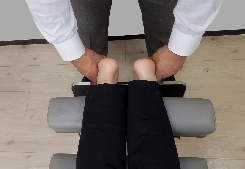 The occurrence of subluxation causes interference with nerve transmission and tension in the muscles under the control of the nerves, resulting in postural distortions such as shoulder height differences, pelvic distortions and various joints in the skeleton.
The occurrence of subluxation causes interference with nerve transmission and tension in the muscles under the control of the nerves, resulting in postural distortions such as shoulder height differences, pelvic distortions and various joints in the skeleton.
This results in short legs and short hands (arms).
 Therefore, by adjusting the subluxation of the upper cervical spine, over time, as the flow and volume of nerve transmission is restored to normal, muscle tension is relieved, posture is improved, and the skeleton returns to its normal position.
Therefore, by adjusting the subluxation of the upper cervical spine, over time, as the flow and volume of nerve transmission is restored to normal, muscle tension is relieved, posture is improved, and the skeleton returns to its normal position.
As a result, short leg and short hands (arms) close to even or became even. For an upper cervical chiropractor, examining your frame balance is more important than knowing what is wrong with you.
4.Palpation
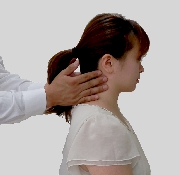 Muscles are attached to the skeleton to hold the posture, but if C1 and C2 are out of their normal positions, the muscles will change their state and pull in one direction.
Muscles are attached to the skeleton to hold the posture, but if C1 and C2 are out of their normal positions, the muscles will change their state and pull in one direction.
Therefore, by palpating the muscles, we can find out which direction C1 and C2 are misaligned, which we call the Listings.
A listing is like a password to use your computer, or a key to open the front door of your car or house, with the direction of the misalignment indicated by the alphabet.
Just as your door can only be opened with your key, knowing your upper cervical misalignment and correcting it is like flipping a switch to return to your natural state of health. In the case of doors, it can be likened to opening a half-open to full open door to facilitate entry and exit.
Subluxations in any part of the spinal column can cause limitations in normal movement.
In particular, a subluxation in the upper cervical spine not only affects the lower spine, but also affects the distant ankle, knee, and hip joints. Therefore, people with these joint problems usually heal spontaneously over time after an upper cervical subluxation adjustment, unless they need surgery or other medical assistance.
5. Analysis of center of gravity and foot pressure
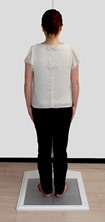 Read the location of center of gravity and foot pressure (load) distribution caused by muscle tension.
Read the location of center of gravity and foot pressure (load) distribution caused by muscle tension.
The measurement is done standing on the measuring plate as shown in the photo (left picture).
Skeletal distortions create differences in the center of gravity shift and the load ratio on the sole that are specific to the skeletal distortions when measured in the standing position.
The standing position of bipedal humans is maintained by nerve transmission from the medulla oblongata located in the upper cervical region (vestibulospinal tract) to the muscles supporting the spine called antigravity muscles.
Subluxation of the upper cervical vertebrae (interference with nerve transmission from the brain) leads to muscle weakness and inability to maintain a stable posture, resulting in misalignment of the arms and legs, and as a result, the center of gravity shifts from the center to the left or right, and in many cases, backward.
As the weight of the body is also shifted toward the heel, the ground contact of the toes becomes worse.
Fig.1, 2009/08/01 shows the position of the center of gravity and foot pressure distribution in a subluxation condition.
The forefoot of the left foot is loaded with 46% of the body weight, while the forefoot of the right foot is loaded with only 28%.
As a result, the toes are hardly touching the ground.

After the adjustment (Fig. 2, 2009/08/01), the shorter hands(arms) and feet was improved, the center of gravity moved to the right front, and the load increased from 28% to 54%, indicating that the right toes were grounded and stability improved.
In Fig.3 09/25/2009 and Fig.4 11/07/2009, the condition after the adjustment was still kept well, and the forefoot was stabilized at an ideal ratio of about 60% of the body weight and the hindfoot (closer to the heel) at about 40%.
As you can see, the left center of gravity and left load (ipsilateral) shown when there is subluxation usually move to the opposite side (right center of gravity and right load) when the subluxation is improved or no subluxation.
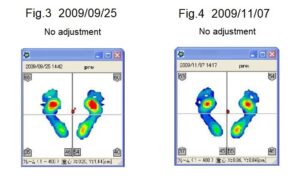
The ideal load ratio for the left and right side is about 50±3 (varies from person to person).
As the subluxation is adjusted and muscle strength is restored following the improvement of nerve transmission from the brain, stability in the standing position improves and the soles of the feet appear more clearly(see Fig.2-4).
In this patient’s case, the characteristic pattern is that the center of gravity comes to the left rear as the short legs and hands(arms) appear.
This case is one of those that show a very ideal improvement.
The healing process varies from person to person, and not all people will follow this ideal process. However, as the body begins to heal, data such as this will be presented so that the patient (you) can visually see the degree of improvement.
Ninety percent of the patients with subluxation who visit our office have a reversal of the forefoot to hindfoot (from the heel) weight ratio. In other words, the forefoot is 30%,40%…with heel-weighted. Ideally, for adults, the forefoot weight should be about 60% and the hindfoot (closer to the heel) about 40%, as mentioned before.
Of course, in some cases, after the adjustment, weight ratio and the center of gravity may move further to the side or backward than before the adjustment, as if they have become even worse (See below Fig. 5 2010/1/24 Post (after Adjustment)). However, this is a transient phenomenon that can be seen in people with muscle weakness due to lack of exercise, lack of sleep, overwork, or continuous stress. The post-adjustment examination only shows the progress of the changes after about an hour, including rest.
At your next visit (See Case 3 weeks later Fig.6 2010/2/14 Pre.), you will see that your posture has been improved by the brain (Innate Intelligence) by restoring enough muscle strength to support the spinal column through normal nerve transmission from the brain, and as a result, the ratio of center of gravity and foot pressure has changed to an quite ideal state.
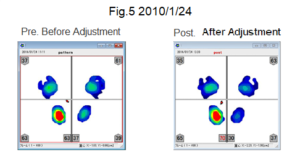

It takes time for the skeleton to stabilize after an adjustment.
Muscle strength is necessary for skeletal stability, and it also takes time for sufficient muscle strength to be restored.
Therefore, in upper cervical chiropractic, it is not important to observe the changes “immediately” after the adjustment, but it is important to observe the changes “subsequent states” after the adjustment.
This is the reason why we allow a period of about two weeks, although it varies from person to person.
During this period, the next examination will confirm how much progress has been made by the natural healing power within you.
Simply put, people with nicely shaped feet find it easier to stand, less tiring, and their bodies recover faster.
People with inadequately grounded fingers will tire easily and have difficulty recovering.
This is a problem that affects the entire body, including the “partial pain” that you complain about. That is why upper cervical chiropractic is not concerned with partial problems (results).
The part is the problem that exists within the whole, and it is your brain and your body’s inherent intelligence that is managing the whole.
These five tests (1-5) are the basic tests that we need as a comprehensive criterion to prove the existence of subluxation.
About the adjustment
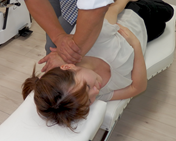 The adjustment is done instantly with C1 or C2 in a horizontal position as shown in the picture, left.
The adjustment is done instantly with C1 or C2 in a horizontal position as shown in the picture, left.
After the adjustment, you will be asked to rest in the same position for about 5 minutes.
After that, you will be asked to move to a booth and take another rest (usually about 30-40 minutes) to stabilize the condition.
For children and infants, the adjustment is done with a light touch, like kissing, using the fingers, accompanied by the parents.
Examination details:
Please watch the introductory video for details. The video is in Japanese, but it will give you an idea of what to expect. (Link to the video)
